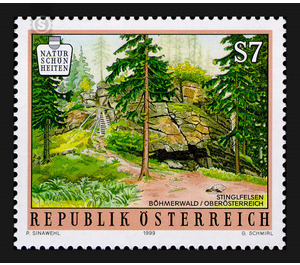nature - Austria / II. Republic of Austria 1999 - 7 Shilling
Theme: Geology & Geography
| Country | Austria / II. Republic of Austria |
| Issue Date | 1999 |
| Face Value | 7.00 |
| Color | green pink |
| Printing Type | combination printing |
| Stamp Type | Commemorative |
| Item Type | Stamp |
| Chronological Issue Number | 1617 |
| Chronological Chapter | OOS-OE2 |
| SID | 620180 |
| In 61 Wishlists | |
Šumava is located in the middle of Europe and, geologically, is one of the oldest parts of Central Europe. 600 million years are the oldest rocks old. The Bohemian Forest is part of the so-called "Bohemian Mass", which is represented in Austria by the Mühlviertel and Weinviertel and is made of granite and gneiss. Today the Šumava lies in the border area of the Czech Republic, Germany and Austria. Since prehistoric times, the Šumava has not only acted as a border, but also had a connecting role. Numerous trade routes enabled the exchange of goods and created connections. The forest also offered people protection against dangers and times of war. In its virginity, the Šumava is one of the most scenic areas in Austria, because the economic exploitation and the resulting destructive effects of nature were due to the location on the dead border until the end of communist rule in the former Eastern Bloc countries in 1989, not as intense as in other areas. Adalbert Stifter, the great son of Šumava, was also inspired by the beauty of the landscape in his world-famous works "Witiko" or "Hochwald".


